Sketchup is Inacurrate???
-
awesome seeing michael's opinion! I wish more devs would talk in that much detail on their apps behavior.
I think he raises some good points about user expectation vs 'true offset' as offsetting may not have a strict geometric definition (at least I've searched around for an actual definition in the course of this thread and couldn't find one )
)that said, I definitely don't think he'd find sketchup's solution acceptable as it doesn't return consistent distance even in the obvious (non corner) areas.
his last examples are good ones for backing up the way moi offsets.. especially the V example as I've built similar shaped walls and I cut the plates the same way as he's shown.
there are equally examples of how that method would be undesirable such as the example I posted earlier when the offset distance is enough to make the arc come back around and start forming a very sharp point. (and I didn't test last night as to what happens if I would of offset that even further.. I'm curious to get to a computer now to test it out
 )
)but I do think he's right that 'an actual strict definition' would be what you get with the round corner option because it give true offset value everywhere along the path. (rhino and illustrator both have those options as well but I left them out of the conversation.. but I now see those options as viable when talking about this stuff)
anyway.. thanks for asking him and @michael, thanks for answering him (though I honestly hope you didn't wade through thiese 30 pages to see me thanking you
 )
) -
@wo3dan said:
@driven said:
@wo3dan said:
Yours is for “nice looking”, not for having accurate predictable measures across, along the segmented arc.
The 'accurate predictable measure' in this example is [r1 to r2] = 1000mm, how more accurate can you get?It can be measured at the shared central 'cardinal' axis on equally segmented arcs.
For an uneven number of segments [r1 - r2] still equals 1000mm.
sorry this is accurate[quote @Jeff (mathematically).. ], any other way is for 'the look'.
Well John, you can't. I'll have to admit that. I was focussing to much on keeping the segments endpoints to where to be convenient (still on a correct true arc location). But any "repair" solution at the end of the child arc (=offset) would then be matematically incorrect. The chord isn't covering the correct angle and not in the exact location.
If I were to choose between a variety of true arc offset solutions in SU, it would be yours. The endpoints may not be located conveniently, but they are on the correct true arc, start to finish! Local measuring may require some tweaking in the number of segments in the child arc. But that doesn't change the true arc('s position)

I think I may have missed an example model along the way so can you permalink me to the post which contains this solution you're talking about ? johns example which I remember didn't have any accurate arc points

fwiw, chord length between segments doesn't have anything to do with accuracy of an arc. and I can show you a few examples where you'll need oddball segment length which varies over the course of an arc.. what matters is that the vertices (no matter how they're spaced) remain a true radial distance from the cpoint.
-
hey Jeff,
can you see any inaccuracy with my effort, it looks better with more sides, but you can still change those...
removed the image showing that the cardinal point still worked when extruded, as I think it caused confusion, try it with the .skp above
john -
@unknownuser said:
I think I may have missed an example model along the way so can you permalink me to the post which contains this solution you're talking about ? johns example which I remember didn't have any accurate arc points :?
http://sketchucation.com/forums/viewtopic.php?f=15&t=44142&start=420#p452970
Hi Jeff, it is the one you slagged off...
john
-
@gilles said:
Try to intersect those geometries correctly.
yeah.. i've seen the 'color by axis' problem before and i think it's just a matter of the tolerance being used as to when to color&display a line as 'on axis'
but that model is off:
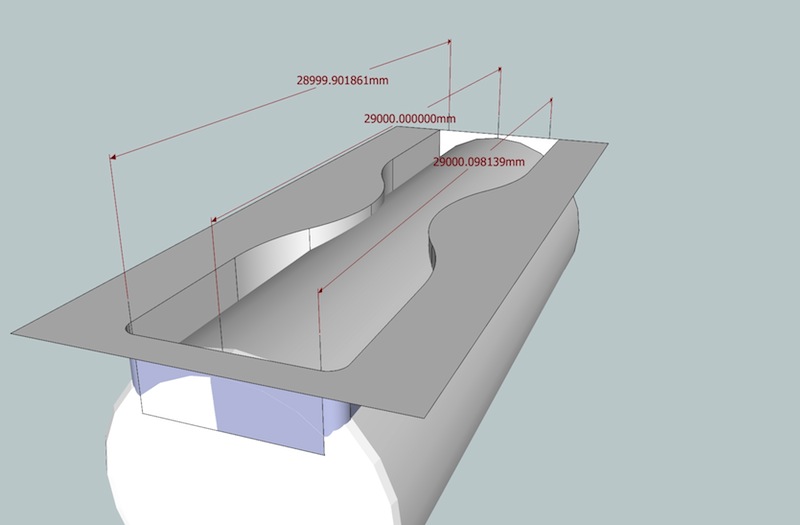
-
@driven said:
@unknownuser said:
I think I may have missed an example model along the way so can you permalink me to the post which contains this solution you're talking about ? johns example which I remember didn't have any accurate arc points

http://sketchucation.com/forums/viewtopic.php?f=15&t=44142&start=420#p452970
Hi Jeff, it is the one you slagged off...
john
ha.. i hope my slagging isn't coming across in an offensive manner.
 (it probably is but i really don't mean it like that)..
(it probably is but i really don't mean it like that)..thing is, you have the arc dimensioned as R1.5m, which it is.. except - it's not sharing the same centerpoint as the R2.5 arc which it definitely should be doing..
-
So is this my inaccuratie or SU?
You can tell me.
-
@gilles said:
So is this my inaccuratie or SU?
You can tell me.
sketchup is inaccurately giving you feedback that your model is accurate

but switch off the whole 'color by axis' thing then get in there and measure and you'll see the model is actually skewed..
[edit]
thankfully, the su devs have a much tighter tolerance set for their inference engine.. if they used the same tolerance for drawing as they did for 'color by axis' then we'd be in a world of hurt!
-
Color by Axis is often incorrect. I've had many models where two models where coloured to be on the same axis, like a wall where I've been unable to cut a hole with PushPull because the faces made from these apparently parallel lines where not parallel after all.
-
@unknownuser said:
sketchup is inaccurately giving you feedback that your model is accurate
That's the point, if draw something I want to know it is good or not, not a "looks good".

-
@gilles said:
@unknownuser said:
sketchup is inaccurately giving you feedback that your model is accurate
That's the point, if draw something I want to know it is good or not, not a "looks good".

yeah.. i hear what you're saying.
in the case of 'color by axis', i tried using that as a troubleshooting measure once a long time ago and found it to be useless regarding accuracy.. so i never used it again

sort of along the same lines but something i really like about rhino..
it lets you adjust the tolerance of the app itself.. granted, it can be really confusing at first and you don't really know how you should set it up until you learn the way the app works but after that phase, it's sweet..say i have my tolerance set to 1/1000th inch.. i now know everything in the model will be at least that accurate.. but what's really good about it is that suppose i try to do an operation which will not be possible within my tolerance..
rhino will tell me "look, if you want to join those surfaces, we're going to have to double your tolerance.. is that ok?"so i can now say "yes.. go ahead" and i'll know my tolerance for that given portion is within 1/500th inch..
where as on sketchup, it won't tell me that.. it just proceeds to fill in any old thing and although i know there's an error, i don't know how much.. but if it could tell me "hey, your arc is off by 1/500th inch here" then at least i know that falls well within what i require for accuracy in which case i would OK the operation..
but it gets back to midway in the thread about tolerances.. sure, a micro error is no big deal in real world but i can make sketchup give a huge error as well.. so having no feedback on the size of the error makes me automatically assume it's the worst possible error..
-
....then you try and use the Query Tool to identify the vert that is causing the problem to be told it is x/y/~0
...you try and fix the ~0 vert but you can't because SU's dislike of small measurements doesn't allow you to fix the error it introduced in the first place.
....fix model doesn't work, make planar doesn't capture it. drape doesn't fix it and so on....
....i suppose it is exaggerating the obvious and making the essential unclear
-
I've been playing with an idea of a cleanup function that will readjust vertices to be perfectly aligned - something that might be able to recover models that act badly, like some DWG imports.
-
@unknownuser said:
ha.. i hope my slagging isn't coming across in an offensive manner.
 (it probably is but i really don't mean it like that)..
(it probably is but i really don't mean it like that)..I'm thicker skinned than that even if it was malicious!!!
@unknownuser said:thing is, you have the arc dimensioned as R1.5m, which it is.. except - it's not sharing the same centerpoint as the R2.5 arc which it definitely should be doing..
where are you seeing this second centre point, I only used the one from the original drawing?
as I said later, I think the 2nd Radius is out by 0.004685mm and SU is correcting that.
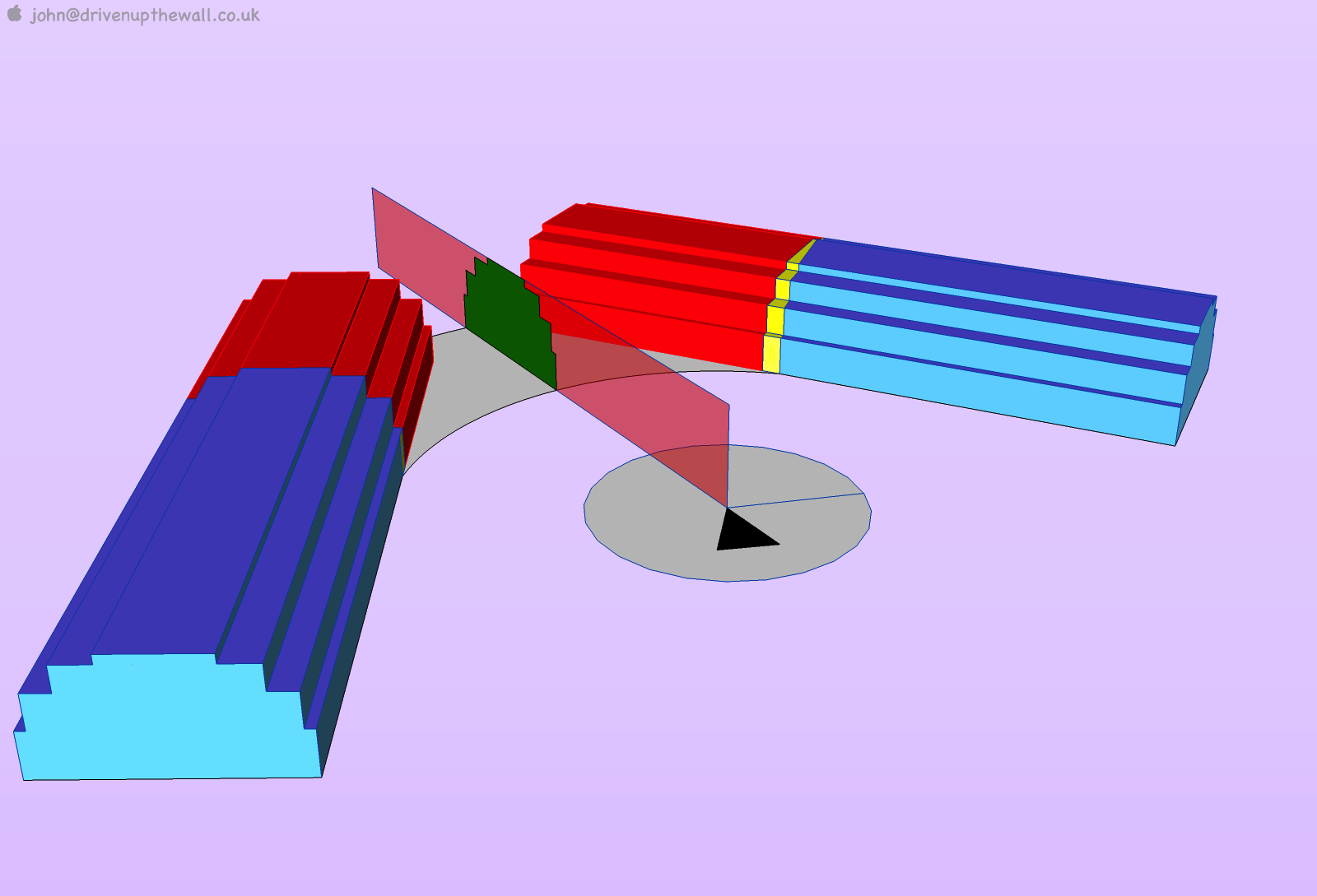
click on profile group and rotate until the line becomes dashed... BTW it only has 1 central axis axis/axlejohn
-
@driven said:
where are you seeing this second centre point, I only used the one from the original drawing?
as I said later, I think the 2nd Radius is out by 0.004685mm and SU is correcting that.john
if you start a line on the tip of the arrow you have drawn then go out to each of the larger arc's vertices, you'll see that you consistently get 2500mm as the length..
if you do that same thing to the inner arc, you'll see that the length varies (and it's never exactly 1500)..
-now-..
delete the arrow you have as the centerpoint.. establish a new centerpoint using the inner arc as reference.. then repeat what i described above.. the inner arc will now consistently measure 1500 to it's vertices whereas the outer arc gives a variety of lengths..ie- they aren't sharing the same centerpoint.
[edit]
an exaggerated (ie-more easy to see with our eyes) version of what's happening looks something like this..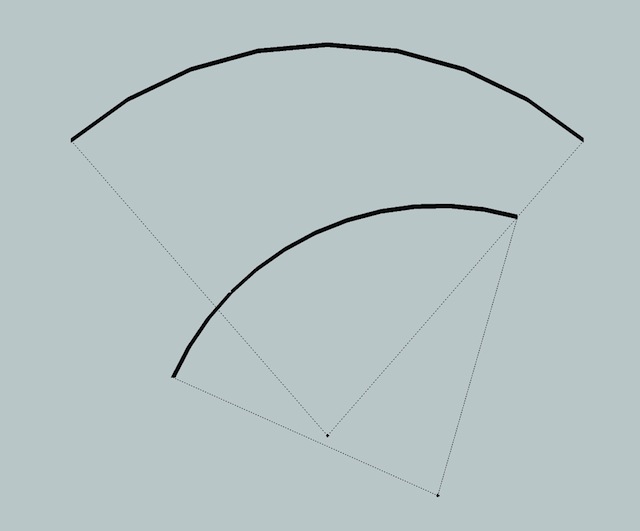
or maybe something like this.. (i haven't got in there to really figure out how it's off.. i just know they're off
 )
)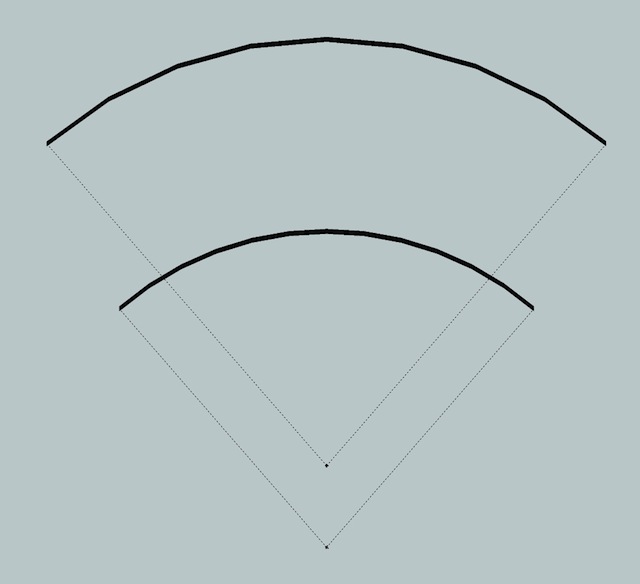
-
@unknownuser said:
ie- they aren't sharing the same centerpoint.
the error was in the radius, which I had mentioned, possibly due to it being a quick lash up.
anyway I think the ~0.005 error is now corrected...
 2Arcs_36sided.skp
2Arcs_36sided.skp -
@driven said:
@unknownuser said:
ie- they aren't sharing the same centerpoint.
the error was in the radius, which I had mentioned, possibly due to it being a quick lash up.
anyway I think the ~0.005 error is now corrected..
getting closer ..now you have to deal with those pesky edges not being parallel..
 (they're not consistently 1000mm apart)
(they're not consistently 1000mm apart)i'm saying though.. this situation is nearly impossible to draw/offset accurately in sketchup.. i'll attach the correct version and i'll also leave the method i used to obtain them in the model (hint- dynamic components running pythagorean theorem calculations on both sides)
that's the only way i can figure out how to do this accurately without leaving sketchup.. but i also feel sketchup could be smarter and do the maths for us

-
@thomthom said:
I've been playing with an idea of a cleanup function that will readjust vertices to be perfectly aligned - something that might be able to recover models that act badly, like some DWG imports.
That would be just the thing. Or make it like the solid inspector so it shows the problem and we can then manually fix it?
-
@unknownuser said:
......I think I may have missed an example model along the way so can you permalink me to the post which contains this solution you're talking about ? johns example which I remember didn't have any accurate arc points

fwiw, chord length between segments doesn't have anything to do with accuracy of an arc. and I can show you a few examples where you'll need oddball segment length which varies over the course of an arc.. what matters is that the vertices (no matter how they're spaced) remain a true radial distance from the cpoint.
You've got the correct model as I can see in later posts.
I know that there are minor differences, maybe even due to having things separated in groups. But the idea is good. That fact that they do not exactly share the same center if you zoom way in, yes you are right. But maybe this is due to speedy modeling to get the idea across. I stick with accepting this as a good offset solution.
And come on, segments not being parallel? so what? If I say corresponding vertices do not line up, then you say 'so what'. Sorry Jeff, in most offsets you can't have both at the same time, that is with arcs being segmented!. I left the idea of vertices being in line towards the center for what it is. I'm going for: all vertices on a true circle, equal segments (number can still be altered) and points at center in the same spot.And you can't be serious when saying that a chord doesn't have anything to do with the accuracy of an arc. Not on its own, but together with the defined radius there's only one arc on either side of the point at center, all vertices on a true circle.
The chord, together with the radius, defines the angle that is covered by the arc.How could the 'Arc' tool work if this weren't true: draw chord > specify (input) radius. Two possibilities as a result. Together one circumference of a whole circle, consisting of two arcs.
-
@wo3dan said:
You've got the correct model as I can see in later posts.
I know that there are minor differences, maybe even due to having things separated in groups. But the idea is good. That fact that they do not exactly share the same center if you zoom way in, yes you are right. But maybe this is due to speedy modeling to get the idea across. I stick with accepting this as a good offset solution.
And come on, segments not being parallel? so what?dunno.. my last post right before yours has the lines parallel as well as true arc measurements so it is possible.. that's all i'm saying.. you don't need to compromise in this situation.. you just gotta calculate it properly..
(re: parallel... i don't mean the segments of the arcs being parallel in john's example.. i'm talking about the straight edges leading into the arcs.. those are simple edge offsets and should be parallel)
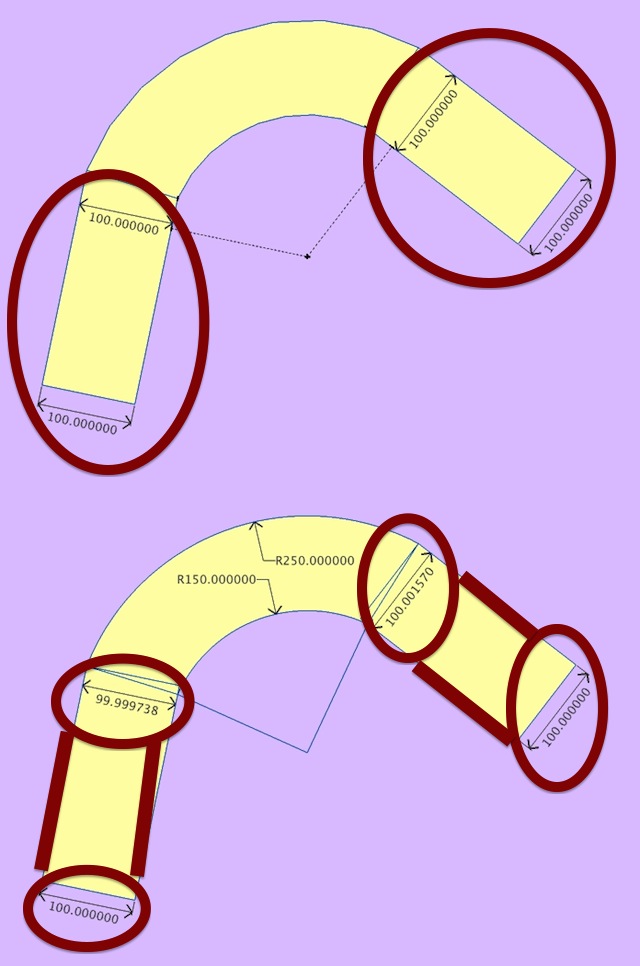
@unknownuser said:
And you can't be serious when saying that a chord doesn't have anything to do with the accuracy of an arc. Not on its own, but together with the defined radius there's only one arc on either side of the point at center, all vertices on a true circle.
The chord, together with the radius, defines the angle that is covered by the arc.right.. the actual chord length of the entire arc is of course of utmost importance..
i thought you were talking about chord length between individual segments of an arc.. in which case, they're irrelevant.. i showed a picture a page or two back which had an arc drawn with all sorts of varying chord lengths amongst it's individual segments.. but it's still an arc in the same way as if it were equally divided and segments had the same chord length..
(i mean... you only need 3 points to define an arc.. the start and endpoints (or chord length if measured that way) then one single point anywhere along it's radius.. that 3rd point doesn't have to be in the middle - it can go anywhere which will created lopsided segmentation but it's still accurate)[but i kinda feel like you're just hellbent on trying to prove me wrong or smthng without actually looking at the various situations/models being discussed..
 ]
]
Advertisement







